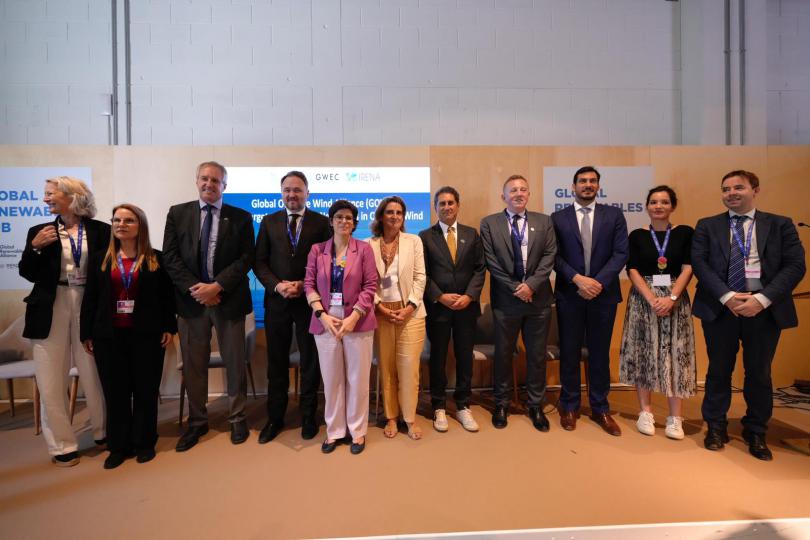For Immediate Release: December 5, 2023
DUBAI, UNITED ARAB EMIRATES – As part of its clean energy leadership, California Energy Commission Chair David Hochschild announced at the COP 28 climate conference in Dubai that California has joined the Global Offshore Wind Alliance (GOWA), whose members collectively seek to build 380 gigawatts (GW) of offshore wind energy by 2030.
The State of California previously set a target of building up to 5 GW of offshore wind energy capacity by 2030 and 25 GW by 2045 as part of its transition to 100 percent clean electricity. Worldwide, installed offshore wind capacity totaled 65 GW in 2022, according to GOWA.
“California is proud to partner with other national and subnational governments around the world to bring clean offshore wind power into the mainstream and achieve 2,000 GW worth of capacity by 2050,” Hochschild said. “The State of California has adopted a 25 GW goal by 2045 for installed offshore wind capacity and believes this clean energy technology offers tremendous benefits both to our grid and to our economy. California is thrilled to join the Global Offshore Wind Alliance in support of this important international goal.”
In addition to contributing capacity to reach the alliance’s 2030 goal, California committed to information sharing and policy and technical exchanges with other members. Being a GOWA member also provides opportunities to learn from other members of the global community, share best practices and potentially strengthen new and existing supply chains.
GOWA, which aims to accelerate global offshore wind capacity, was founded by the Danish Ministry of Climate, Energy, and Utilities, the International Renewable Energy Agency (IRENA) and the Global Wind Energy Council (GWEC). The alliance officially launched in 2022 at COP 27 in Sharm el-Sheikh, Egypt. Members include Australia, Belgium, Colombia, Denmark, Germany, Ireland, Japan, the Netherlands, Norway, Portugal, Spain, Saint Lucia, the United Kingdom, and the United States.
California is home to some of the best conditions for offshore wind in the United States, a power source that can play a major role in helping the state achieve 100 percent clean electricity and carbon neutrality. Offshore wind is a critical clean energy source, complementing solar energy by providing generation at the end of the day and into the evening as the sun sets.
Offshore wind has enormous untapped potential to drive the global clean energy transition. Analysis by the World Bank based on the Global Wind Atlas estimates that technical offshore wind resources amount to over 71,000 GW globally.
Additional Actions on Offshore Wind
State Investments: Economic benefits of offshore wind are expected come from investments in seaport and waterfront facilities. Plans are underway for renovations at the Port of Humboldt Bay with $10.5 million in funding approved by the CEC in March 2022.
First Lease Sale: In December 2022, the Bureau of Ocean Energy Management, which manages the development of the nation’s offshore energy and mineral resources, held the first California sale for offshore wind leases. This auction resulted in awards to five lease holders off California’s North and Central Coasts.
Job Creation: In addition to providing clean renewable energy, California’s offshore wind industry is expected to create a wide range of good-paying jobs, as explored in a December 2022 report titled A Preliminary Assessment of Economic Benefits of Offshore Wind. Most jobs are expected to be in the local and regional supply chain and manufacturing sectors, although other jobs, such as dock workers and watercraft operators, would also be created. The report is one of three contributing to the development of the state’s Offshore Wind Strategic Plan, as directed by Assembly Bill (AB) 525.
Federal Partnership: In February 2023, California signed onto a White House-led federal-state partnership designed to fast-track efforts to bring cleaner and cheaper energy to Americans, create good-paying jobs and build an American supply chain for offshore wind.
International Collaboration: Also in February 2023, the CEC and the Danish Energy Agency signed a new agreement to promote sharing of knowledge, experiences, data, and best practices for offshore wind energy.
State Permitting: In May 2023, the CEC adopted another report in response to AB 525 describing various options for a coordinated, comprehensive and efficient offshore wind permitting and environmental review process. Due to steep drop-offs and deep waters found off the coast of California, projects will be among the first in the world to use floating platforms.
Stakeholder Engagement: To strengthen collaboration, in May 2023, the CEC hosted an offshore wind energy symposium, featuring a U.S. Department of Energy workshop, to discuss the efforts necessary to advance floating offshore wind, learn about the international experience and identify what it will take to make the first West Coast floating offshore wind projects successful.
To learn more about California’s offshore wind efforts, visit the CEC’s Offshore Renewable Energy Page.
###
About the California Energy Commission
The California Energy Commission is leading the state to a 100 percent clean energy future. It has seven core responsibilities: developing renewable energy, transforming transportation, increasing energy efficiency, investing in energy innovation, advancing state energy policy, certifying thermal power plants, and preparing for energy emergencies.
Newsroom
Media Contact
Media and Public Communications Office
MediaOffice@energy.ca.gov
(916) 654-4989

